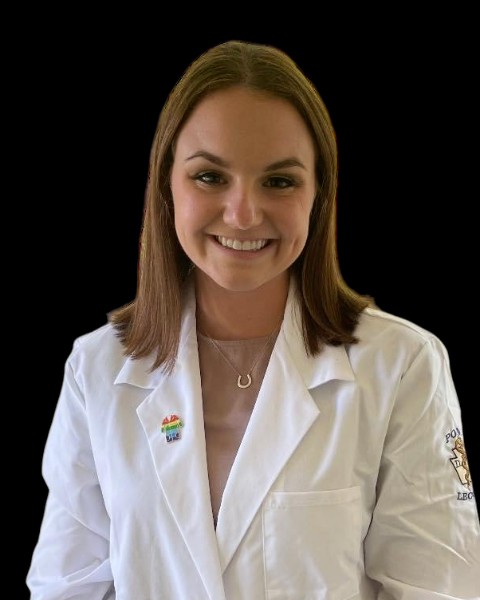PQA 10 - PQA 10 Head & Neck Cancer and Health Services Research/Global Oncology Poster Q&A
3694 - Matched Cohort Analysis of Hypofractionated Adjuvant Radiation Therapy for Salivary Gland Cancer
Wednesday, October 2, 2024
10:30 AM - 11:45 AM ET
Location: Hall C
Screen: 25

Brianna McGowan, BA
Lake Erie College of Osteopathic Medicine
Erie, PA
Presenter(s)
B. McGowan1, C. Billena1, Z. S. Mayo1, N. M. Woody2, J. A. Miller2, S. A. Koyfman2, and S. R. Campbell2; 1Department of Radiation Oncology, Cleveland Clinic Foundation, Cleveland, OH, 2Department of Radiation Oncology, Taussig Cancer Institute, Cleveland Clinic, Cleveland, OH
Purpose/Objective(s): Hypofractionated radiation therapy (HRT) is not historically used to treat head and neck cancer (HNC). However, patients with salivary gland (SG) cancer typically have minimal mucosal exposure, the area at highest risk of toxicity related to HRT. This study reviews our institutional experience using intensity modulated HRT for major SG HNC. Materials/
Methods: An IRB approved 2:1 matched cohort analysis of 63 patients treated with surgery followed by adjuvant radiation for major SG HNC was conducted. 42 patients treated with standard fractionation (SRT) of 50-70Gy in 25-35 fractions were matched to 21 patients treated with HRT using = 50Gy in 20 fractions. Matching was based on tumor stage, histology, patient age, and use of concurrent chemotherapy. The primary outcomes were toxicity and locoregional control. Fisher’s exact test was used for acute toxicity and outcome comparison between groups.
Results: Median follow up was 29 months (range 8-67) for HRT and 54 months (range 11-182) for SRT. Median age for both groups was 73 years. Oncologic control was not significantly different with local recurrence of 9.5% in each group, regional recurrence of 4.8% in HRT and 0% SRT, and distant recurrence of 14.3% in HRT and 23.8% in SRT. Acute toxicity (absent vs grade 1+) from HRT was not different compared to SRT (all p>0.05) for dysphagia, mucositis, dermatitis, trismus, taste changes, pain, anorexia, weight loss, fatigue, and diet changes. Acute grade 1+ xerostomia was more common in SRT than HRT (78.6% vs 52.4%, p=0.04), but not grade 2+ (p=0.52). There was no grade 3+ acute toxicity in HRT. No patients required feeding tube or tracheostomy. In HRT, late toxicity was grade 1 xerostomia in 42.9%, dysphagia and taste change in 19%, fatigue and skin fibrosis in 14.3%, pain in 9.5%, and trismus and voice change in 4.8%. Grade 2 xerostomia was reported in 9.5% and there were no grade 3+ toxicity.
Conclusion: Adjuvant HRT for SG HNC is safe and effective, with no difference in acute toxicity and oncologic control in this matched cohort of SRT. Late toxicity in HRT was minimal. This represents a group of HNC patients that radiation oncologists can likely safely reduce treatment time and burden on.
Purpose/Objective(s): Hypofractionated radiation therapy (HRT) is not historically used to treat head and neck cancer (HNC). However, patients with salivary gland (SG) cancer typically have minimal mucosal exposure, the area at highest risk of toxicity related to HRT. This study reviews our institutional experience using intensity modulated HRT for major SG HNC. Materials/
Methods: An IRB approved 2:1 matched cohort analysis of 63 patients treated with surgery followed by adjuvant radiation for major SG HNC was conducted. 42 patients treated with standard fractionation (SRT) of 50-70Gy in 25-35 fractions were matched to 21 patients treated with HRT using = 50Gy in 20 fractions. Matching was based on tumor stage, histology, patient age, and use of concurrent chemotherapy. The primary outcomes were toxicity and locoregional control. Fisher’s exact test was used for acute toxicity and outcome comparison between groups.
Results: Median follow up was 29 months (range 8-67) for HRT and 54 months (range 11-182) for SRT. Median age for both groups was 73 years. Oncologic control was not significantly different with local recurrence of 9.5% in each group, regional recurrence of 4.8% in HRT and 0% SRT, and distant recurrence of 14.3% in HRT and 23.8% in SRT. Acute toxicity (absent vs grade 1+) from HRT was not different compared to SRT (all p>0.05) for dysphagia, mucositis, dermatitis, trismus, taste changes, pain, anorexia, weight loss, fatigue, and diet changes. Acute grade 1+ xerostomia was more common in SRT than HRT (78.6% vs 52.4%, p=0.04), but not grade 2+ (p=0.52). There was no grade 3+ acute toxicity in HRT. No patients required feeding tube or tracheostomy. In HRT, late toxicity was grade 1 xerostomia in 42.9%, dysphagia and taste change in 19%, fatigue and skin fibrosis in 14.3%, pain in 9.5%, and trismus and voice change in 4.8%. Grade 2 xerostomia was reported in 9.5% and there were no grade 3+ toxicity.
Conclusion: Adjuvant HRT for SG HNC is safe and effective, with no difference in acute toxicity and oncologic control in this matched cohort of SRT. Late toxicity in HRT was minimal. This represents a group of HNC patients that radiation oncologists can likely safely reduce treatment time and burden on.
